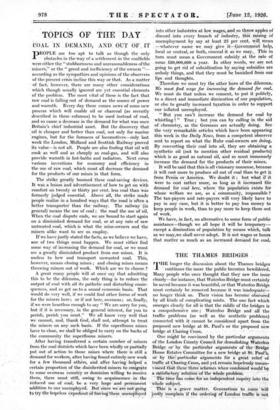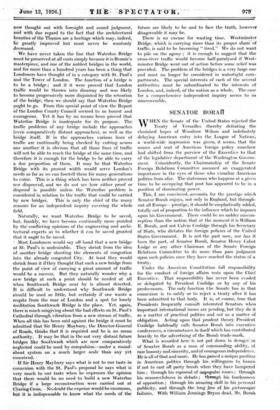THE • THAMES BRIDGES ...
'THE longer the discussion about the Thames bridges continues the more the piiblic becothes bewildered. Many 'people who once thought that they saw the issue clearly—for instance, that Waterloo Bridge must certainly be saved because it was beautiful, or that Waterlob Bridge Must certainly be removed because it was iriadepiate; -no -longer think' so. Their visiOn has become obsenied by all kinds of complicating mists. The one fact which enierges clearly for all is that the riddle of the bridges is a comprehensive one;' Waterloo Bridge and all the traffic/ problems (as well as the aesthetic probleins) Connected with it: cannot be, considered apart from the -proposed new bridge at St. Paul's or the proposed new bridge at charing Cross. '
-One. knight be convinced by the particular arguments of the LOild-011 Nunty Council for demolishing Waterloo Bridge: or" by the particular argruirenta of the Bridge House Estates Committee for a new bridge at St Paul's; by the; particular argrimenis far a great relief of traffic at Charing-Cross,- and -yet remain hopelessly uncoil- -virieed that thesethreescheines when combinedWould be a satisfactory solution of the Whole probleni. The time fias cOille for an independent inquiry into the whole subject. - This is a grave matter. Generations to collie will Justly complain ifthe ordering of London traffic is not . . . now thought out with foresight and sound judgment, andwith due .regard to the fact that the architectural beauties of the Thames are a heritage whichmay, indeed, be greatly: `iniproVed but Must never be` wantonly decreased. - * - - ' have never talcen the line that Waterloo -Bridge Inuit be preserved at all costs simply because it is-Rennie's masterpiece, and one of the noblest bridges in the world; and for more than a hundred years has been a thing that Londoners have thought of in a category with St. Paul's and the Tower of London. The function of a- bridge is to be a bridge ; - and if it were proved ' that London till* Would be thrown into disarray and was likely to become progressively mare disjointed by the retention of the bridge; then we should say that- Waterloo Bridge Ought to go. From this special point of view the Report of the London County Council Seemed to us honest and Courageous. Yet it has by no means been proved that Waterloo Bridge is inadequate for its purpose: The traffie problems of any bridge include the approaches (even comparatively distant approaches, as Well as the bridge itself: If in the approaches various lines of traffic' are eontiniiallY being checked' by cutting acress one another' it is obvious that all those lines of traffic Will'not be able to reach the bridge at the same time, and therefore it is enough' for the bridge to be able to 'carry n due proportion of them. It may be that Waterloo Bridge With its preient width would serve London's needs- so far as can'foretell them fOr many generations to -cane. This is a thing which has been neither proved nor disproved, and We do not see how either proof or disproof is possible unless the Waterloo' problem is considered in relation to the traffic that Could be carried by new bridges. This is only the chief of -the many reasons for an independent inquiry covering the whole field. Naturally, we want Waterloo Bridge to be saved, but, frankly, we have become continually more Fizzled by the- conflicting opinions of the engineering and archi- tectural experts as to whether it can be saved granted that it ought to be *saved. r -Most Londoners Would say off hand that a new bridge at St:- Paul's is undesirable. They shrink from the-idea _ _ Of another bridge Shooting the elements Of congestion into the already congested City. At least they would shrink from it if they thought that such a new bridge from the point of view of carrying a great amount of traffic would be a success. But they naturally wonder why a new bridge at such a- point should -be needed at all when Southwark -Bridge near by is almost deserted. It is difficult to understand why Southwark Bridge should be used so little; but certainly if one wants a respite from the roar of London and- a spot for lonely Meditation Southwark Bridge is the place. Yet,- again, there is much misgiying about the bad effects on St. Paul's Cathedral through_ vibration -from a new stream of traffic. When all this has been said against the bridge it must be - admitted that Sir Henry Maybury,- the -Director-General Of Reads, thinks that it is required- ittid Is no -mean authority. It May be that in the not very distant future bridges like :Southwark whieh are riow, coniparatively neglected -mild be used by compulsion—under about system on a- much larger than- anY yet Conceived. _ If Sir Henry Maybury says what_ is not to our-taste-in Connexion with the St-Paul's -proposal he says Whit very mu& to our taste when he expresses the opinion that there -would be no need to build a new Waterloo Bridge if a large reconstruction were carried out at CharingCross. NO doubt the expense Would be enormous, but it -is indispensable the future are likely to be and to face the truth, however disagreeable it may be-. There is no excuse for wasting time. - Westminster Bridge, whkh- Carrying More than itsproper share of' traffic, is said to be becoming " tired." We do not -want to pile on the agony; it is enough to suggest that the eross-river traffic would become half-paralysed if West- minster Bridge went out of action before some relief was provided. The problem of the -bridges is a very large one and must no longer be considered in watertight com- partments. The special interests of each of the several authorities must be subordinated to the interests of London, and, indeed, of the nation as a whole. The case for a comprehensive -independent inquiry seems to us unanswerable.























































 Previous page
Previous page